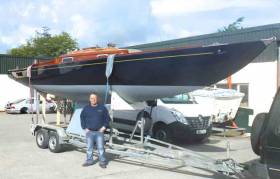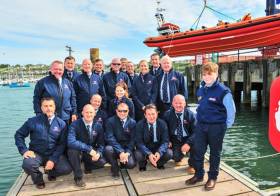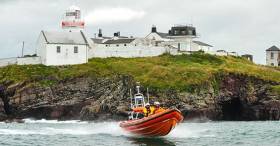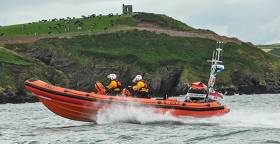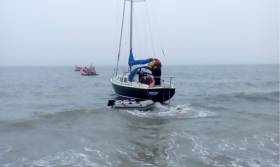Displaying items by tag: Crosshaven
Traditional Boats in Crosshaven This Weekend
Preserving traditional boats is very important, using them even more so and racing them a sight to behold writes Tom MacSweeney. All can be seen this weekend at Crosshaven in Cork Harbour where vintage boats of all types, shapes and sizes will gather for the annual Crosshaven Traditional Sail.
It begins this evening with the official opening at the Oar Bar in the village at 7.30 p.m. Boats will be at the Hugh Coveney Pier where Skippers will be briefed at 1230 on Saturday about the first race, scheduled to start at 2 pm off ‘the Grassy,’ traditional sail race starting point for generations of sailors.
There is another race scheduled for Sunday, again at 2 p.m., with a Parade of Sail afterwards.
What I particularly like about the traditional boat people is their ‘relaxed’ approach to sailing. They make it a strong social occasion when they gather. They are a magnificent sight racing in the harbour, boats of many kinds, and sails of several colours.
There will also be a ‘Pirates Trail’ and a ‘Seafood Trail’ to be followed.
“Our purpose is to make sailing enjoyable and show how valuable it is for our maritime heritage and culture not only to preserve the traditional boats, but to keep them in use. That’s the purpose of a boat, to use and enjoy it,” the organisers say. There will be prizes for the racing, for the best dressed boat, best dressed crew, oldest and youngest crew and the boat which travels further to reach Crosshaven.
Etchells 22 Super De Luxe Heads For Crosshaven
As Johnny Smullen, boatbuilder to America’s Cup legend Dennis Conner has put it, the transformation job on a tired old Etchells 22 is simply amazing writes W M Nixon
The well-worn white hull of a standard Etchells 22 went into Bill Trafford's shed near Skenakilla Crossroads in March last year. And this week, the gorgeous dark blue cruising sloop Guapa (it’s Spanish for beautiful) emerged. See our April progress report here.
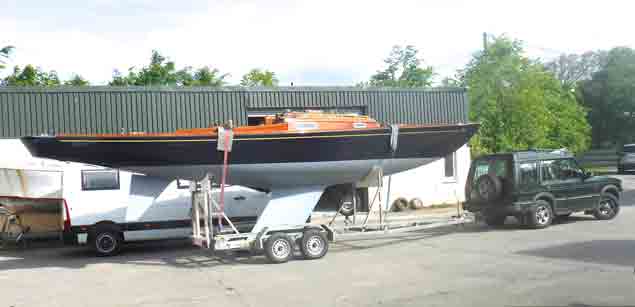 Elegance is the hallmark
Elegance is the hallmark
Next Wednesday she’ll be arriving in Crosshaven for her mast to be stepped and new sails fitted from Des McWilliam. But the boat is so utterly transformed, with judiciously-raised topsides and an extremely elegant Scandinavian-style coachroof and comfortable accommodation within, that Bill naturally wondered if his calculations as to the new location of the waterline were accurate.
Indeed, like every boat-transformer, he wondered if she’d float. So rather than give her a totally-untested debut at Crosshaven, Guapa was quietly towed up the road to Doneraile, where the equipe stopped outside the Townhouse Tea Room for some sustenance, as Bill’s wife works there (and it’s Georgina Campbell-recommended).
 Quick sustenance stop as viewed from the Townhouse tea Room in Donraile
Quick sustenance stop as viewed from the Townhouse tea Room in Donraile
Then it was on up the road to Adare and down to Askeaton off the Shannon Estuary, where Cyril Ryan at his boatyard had the crane ready, and Guapa had her first splash in complete privacy. No leaks. And she floated perfectly on her marks. All being well, next Wednesday in Crosshaven, you’re in for a treat.
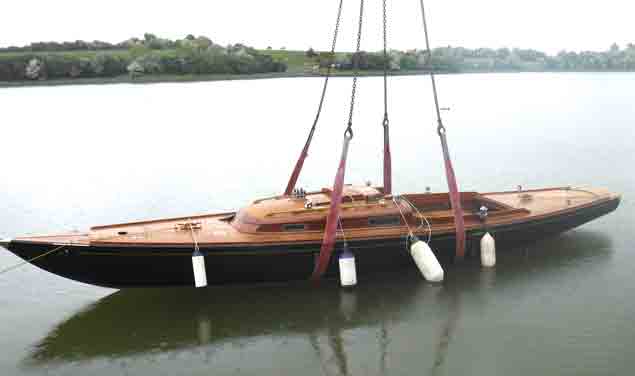 At Askeaton, Guapa floats to her marks
At Askeaton, Guapa floats to her marks
Red Bay Lifeboat Rescues Three Off Glenarm
#RNLI - Red Bay RNLI’s lifeboat was launched yesterday afternoon (Sunday 5 February) to locate and rescue three people on board a 13ft boat off Glenarm Bay.
The lifeboat crew located the vessel, which had suffered engine failure, three miles east of Glenarm Marina.
Two people on board the boat were transferred to the lifeboat before the vessel was taken in tow to Glenarm.
The three men were on a fishing trip and contacted Belfast Coastguard by mobile phone to raise the alarm. Sea conditions were calm with freezing temperatures.
Around the same time, the volunteer lifeboat crew at Crosshaven RNLI in Cork Harbour launched to assist a grounded yacht.
On arrival, the lifeboat transferred a crew member to the yacht and made good a towline. Before the tow commenced the yacht's integrity was checked.
After successfully towing the vessel into deep water, another check for leaks was made before the yacht and its crew were happy to make their own way to East Ferry.
Crosshaven Boatyard Set For Sale As Going Concern
#CorkHarbour - Doyle Shipping Group will concentrate its core stevedoring business in Dublin, Cork and elsewhere in Ireland as it prepares to offer Crosshaven Boatyard for sale as a going concern this year.
That’s according to yard manager Matt Foley, who confirmed plans to the Irish Examiner upon speculation that the established Cork Harbour fixture would go on the market in the coming months, potentially asking in the region of €4-5 million.
Though the yard left the boatbuilding trade many years ago — with a legacy that includes Denis Doyle’s Moonduster yachts, Sir Francis Chichester’s Gypsy Moth V and Tim Severin’s St Brendan replica — it continues as a storage and servicing facility, employing seven.
The Irish Examiner has much more on the story HERE.
Two New RNLI Inshore Atlantic 85 Class Lifeboats Officially Named in County Cork
There were double celebrations for the RNLI in County Cork this weekend with two new lifeboats officially named and blessed in Youghal and Crosshaven.
At a special ceremony held on Saturday, Youghal RNLI officially named its new Atlantic 85 class lifeboat, Gordon and Phil, while today (Sunday 11 September) Crosshaven RNLI named its new lifeboat John and Janet.
The honour of naming Youghal’s new lifeboat went to eight-year-old Izzy O’Connell, and Albert Muckley, Deputy Launching Authority.
Izzy who was diagnosed with a brain tumour in 2014 is a friend of the station. The lifeboat crew who have admired Izzy’s determination and courage, wanted her to play a special part in their day.
Ahead of the naming, Catherine Fitzgerald Hourigan, who has held several fundraising events in aid of the station, was invited to represent the late donor Gwenda Bull, and hand the new lifeboat to the RNLI.
Peter CrowIey, RNLI Vice President, accepted the lifeboat on behalf of the RNLI before handing her over into the care of Youghal Lifeboat Station. The lifeboat was then accepted on behalf of the crew by Lifeboat Operations Manager Fergus Hopkins.
Gwenda Bull, who lived in Brighton, East Sussex, admired the work of the RNLI as did her family. She funded various equipment for Shoreham lifeboat station and went to see the new Tamar lifeboat arrive at Shoreham back in December 2010.
Miss Bull also kindly funded the purchase of a new inshore lifeboat, to be named Gordon and Phil in memory of her parents. She was happy for the lifeboat to go on station wherever it would be of most benefit around the coast, so her funds were used to purchase the new B class lifeboat in Youghal.
Mr Hopkins remembered and thanked Miss Bull, adding that her generosity had given Youghal RNLI a lifesaver.
‘When the crew arrive here,’ he said, ‘and get kitted up, and head out to sea, we’ll have peace of mind. Because this lifeboat will help to keep them safe, as they save others’.
Pat O’Keefe, fundraising committee member recounted a historical call out before the Very Reverend David Herlihy, Parish Priest, the Very Reverend Alan Marley and the Reverend Tim Kingston lead the Service of dedication. Izzy and Albert then officially named the lifeboat Gordon and Phil, while pouring a bottle of champagne over the lifeboat which then put to sea.
The new lifeboat replaced Patricia Jennings which during her 13 years in Youghal launched 175 times with its crews saving nine lives and rescuing 233 people.
The celebrations moved to Crosshaven this afternoon where the honour of naming the lifeboat went to young Paddy Crowley, son of the late Con, who was a helm at the station prior to his sudden death last year.
Afloat journalist Tom MacSweeney was invited to represent the anonymous donor of the new lifeboat John and Janet and hand her over to the RNLI.
Speaking at the ceremony, Mr MacSweeney said: ‘On this occasion, the incredibly generous donor of this new lifeboat has decided to remain anonymous. We can all agree this is an incredible act of kindness and so I offer my sincere thanks to the donor and I know this lifeboat will be a much loved asset to the community of Crosshaven.’
Clayton Love, RNLI Vice President, accepted the lifeboat on behalf of the RNLI and handed her into the care of the Crosshaven lifeboat crew. It was Mr Love’s family who kindly donated the station’s former lifeboat, Miss Betty.
On accepting the lifeboat, Patsy Fegan, Lifeboat Operations Manager said: ‘People from all walks of life represent our volunteers who without a thought at any time day or night will drop everything when their pager goes off and come down to the station. When the crew arrive here, they prepare themselves and the boat, don their suits and go to sea to save the lives of others. This new Atlantic 85 class lifeboat will help to keep our volunteer crew safe, as they rescue others.’
The Very Reverend Fr Pat Stevenson and Reverend Isobel Jackson lead the Service of Dedication before Paddy Crowley, son of the late Con, officially named the lifeboat John and Janet.
Last year, Crosshaven RNLI launched 42 times and rescued 50 people. The new lifeboat replaces Miss Betty, the station’s first permanent lifeboat, which was on service in Crosshaven since the station was formally established 14 years ago.
The new state of the art Atlantic 85 lifeboat was introduced into the RNLI fleet in 2005. The lifeboat is 8.4 metres in length and weighs 1.8 tonnes. Improvements on its predecessor include a faster top speed of 35 knots, radar, provision for a fourth crew member and more space for survivors.
Fast, manoeuvrable and reliable, the B class operates in rough weather conditions, capable in daylight up to force seven and at night, to force six winds.
The new lifeboat, an Atlantic 85 is the latest version of the B class.
Crosshaven RNLI New Inshore Lifeboat To Be Named 'John and Janet'
A new Atlantic 85 lifeboat for Crosshaven RNLI is to be officially named John and Janet during a ceremony at the Cork lifeboat station at 2pm on Sunday 11 September.
The lifeboat which went on service in June this year was funded by an anonymous donor. Afloat.ie's Tom MacSweeney will represent the donor at the naming ceremony and service of dedication and will officially hand the lifeboat into the care of the RNLI.
The lifeboat will be named by Paddy Crowley, son of the late Con, a long serving and much loved helm at Crosshaven RNLI who died suddenly last year.
Last year, Crosshaven RNLI launched 42 times and rescued 50 people. The new lifeboat replaces Miss Betty, the station’s first permanent lifeboat, which was on service in Crosshaven since the station was formally established 14 years ago.
Speaking ahead of next week’s event, Patsy Fegan, Crosshaven RNLI Lifeboat Operations Manager said: ‘The naming ceremony and service of dedication is a very special occasion for our lifeboat station and we are grateful to the anonymous donor who funded our new lifeboat. Since the lifeboat went on service in June, it has launched 17 times and rescued 34 people.’
Fast, manoeuvrable and reliable, the B class operates in rough weather conditions, capable in daylight up to force seven and at night, to force six winds.
The new lifeboat, an Atlantic 85 is the latest version of the B class, introduced into the fleet in 2005. She is powered by two 115horsepower engines and has a stronger hull and greater top speed than her predecessor. The added radar allows the crew to operate more effectively in poor visibility and she also has VHF direction-finding equipment.
The vessel also has a manually operated self-righting mechanism which combined with inversion-proofed engines keep the lifeboat operational even after capsize. The lifeboat can also be beached in an emergency without causing damage to its engines or steering gear.
The Atlantic 85 carries a full suite of communication and electronic navigation aids, as well as a searchlight, night-vision equipment and flares for night-time operations.
The RNLI first established Queenstown Lifeboat Station in 1866, following several wrecks with loss of life off Cork Harbour. However, the first record of a lifeboat in Cork Harbour was as far back as 1825, one year after the founding of the Institution.
Since the closure of Queenstown in 1920, many attempts were made to site a lifeboat in the harbour.
Based on the level of activity in the area, the availability of crew and temporary facilities, a decision was taken to place an Atlantic 21 on evaluation for 12 months in 2000 before the RNLI declared the station a permanent facility in 2001.
Miss Betty, the station’s first permanent lifeboat arrived in 2002 where she remained on service until June this year.
The RNLI is a charity which relies on voluntary contributions and legacies.
Crosshaven RNLI Lifeboat crew responded to a request from Valentia Coast Guard this evening to a person seen being held onto the side of a moored boat in the Channel at East Ferry.
The Crosshaven volunteer crew happened to be near Roches Point on exercise when the emergency call came through and immediately made best speed to the area arriving some 15 minutes later at 20.45. The crew located the casualty and recovered him to the lifeboat.
It appears the sailor had the mishap while transferring to a punt. The other person required no assistance.
With obvious signs of hypothermia and limb injuries after spending 20/25 minutes in the water, the lifeboat crew administered First Aid and headed for Cobh and a rendevous with the Emergency Ambulance. The casualty was handed into the care of the paramedics before returning to station at 21.50.
Crosshaven RNLI Launch to Supermarket Dinghy Blown Out to Sea
Crosshaven lifeboat was launched this afternoon after a member of the public alerted the Coast Guard to an inflatable Dinghy with thre persons on board being blown out to sea.
The lifeboat launched at 14.52 and made their way to Ringabella Bay arriving on scene at 3.10pm. No sighting of the dinghy initially was made, but the crew noticed a Supermarket type inflatable dinghy on the shore at Ringabella beach. A crew member swam ashore and talked to the owners who confirmed they were the 3 people that had left Fountainstown. As they were now ashore and safe all units were stood down.
The occupants were wearing swim gear apart from one who had a wetsuit and a bouyancy aid. The wind offshore was blowing force 5 to 6 although calmer within the bay. Crosshaven Coast Guard imparted safety information to the people involved.
Commenting on the service call, Patsy Fegan, Lifeboat Operations manager said "The use of inflatables and lilo's should only be used in the confines of a swimming pool. Luckily these people came to no harm, but with a force 5 wind they could have drifted well offshore”
As well as Crosshaven Lifeboat, other agencies involved were Rescue 117 helicopter from Waterford, The Naval vessel, LE Niamh which acted as a Radio Relay to the Coast Guard and the Crosshaven Coast Guard boat.
#RNLI - A major search was mounted on the south coast between Crosshaven and Kinsale on Friday (15 July) after a lone yachtsman broadcast a Mayday call that he was on the rocks at the Little Sovereign Rock.
Lifeboat pagers were activated at 12.07pm and both Crosshaven and Kinsale RNLI headed to the location, joined by Crosshaven Coast Guard and the Waterford-based Irish Coast Guard helicopter Rescue 117.
Conditions were poor on scene, with a fog reducing visibility to just 200m. Kinsale RNLI found no trace of the yacht at the Sovereigns, while Crosshaven RNLI searched the shore from Roberts Head west. Crosshaven Coast Guard stood offshore as a radio relay to Valentia Coast Guard.
The Crosshaven lifeboat crew eventually located the vessel aground in Rocky Bay. One crewmember swam to the yacht with a towline and retrieved the its anchor and line. The yacht was then refloated and towed into deeper water.
After handing off the tow to Kinsale RNLI, the vessel and its yachtsman were returned to Oysterhaven none the worse for wear.
Crosshaven Lifeboat Helm Appointed To RNLI Council
#RNLI - Crosshaven RNLI has announced that Ian Venner, a helm with the crew, has been appointed to the RNLI Council for Ireland as one of its 15 members.
Venner has been a member of the lifeboat crew and a helm since the station was re-established in 2000.
An accountant by profession and a keen powerboater, Venner replaces on the council well-known Cork businessman and sailor Peter Crowley, who after 10 years on the council becomes an RNLI vice president.
The RNLI Council acts in the interest of the RNLI in the Republic and Northern Ireland and makes recommendations and gives advice to the RNLI Board, the Council and the Executive Team concerning lifeboat matters.




























